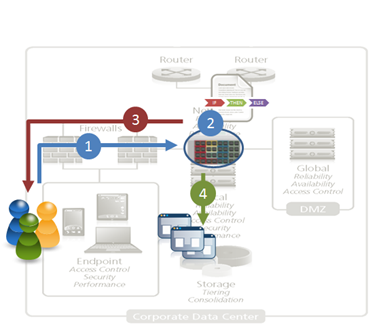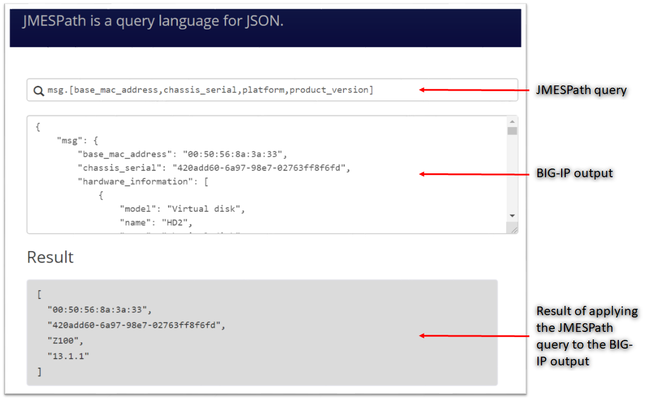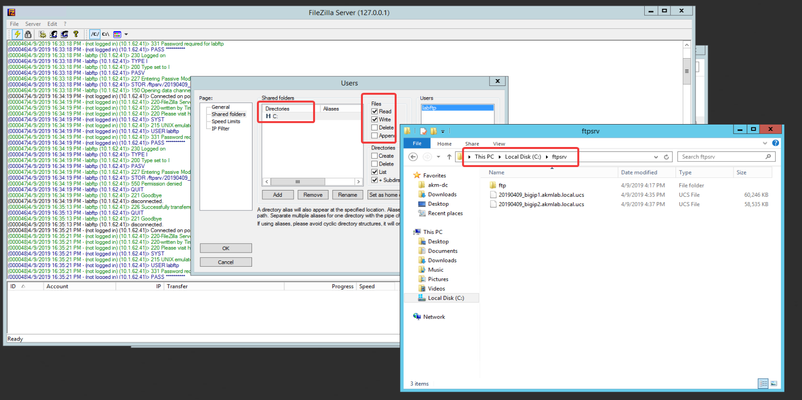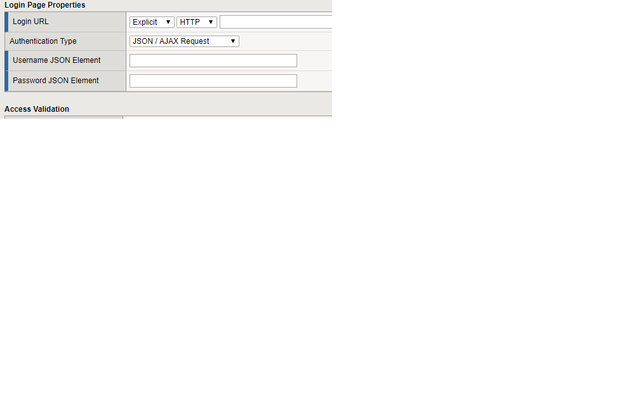json
37 TopicsASM issue, need to return HTTP 500 to client in certain cases
I've written a script that captures the "Content-Type" header from requests. In the event that ASM blocks the request, I need to respond to the client with one of three types of responses (I'm using the ASM_REQUEST_BLOCKING event): If Content-Type = text/xml then send back a SOAP error with HTTP 200 If Content-Type = application/json then return HTTP 500 All others return the default ASM response with HTTP 200. Cases 1 & 3 are handled, but I can't figure out how to force an HTTP 500 status to be returned to the client. HTTP_RESPONSE doesn't fire when ASM blocks. Thanks for your advice.Solved4KViews0likes6CommentsInfrastructure Architecture: Whitelisting with JSON and API Keys
Application delivery infrastructure can be a valuable partner in architecting solutions …. AJAX and JSON have changed the way in which we architect applications, especially with respect to their ascendancy to rule the realm of integration, i.e. the API. Policies are generally focused on the URI, which has effectively become the exposed interface to any given application function. It’s REST-ful, it’s service-oriented, and it works well. Because we’ve taken to leveraging the URI as a basic building block, as the entry-point into an application, it affords the opportunity to optimize architectures and make more efficient the use of compute power available for processing. This is an increasingly important point, as capacity has become a focal point around which cost and efficiency is measured. By offloading functions to other systems when possible, we are able to increase the useful processing capacity of an given application instance and ensure a higher ratio of valuable processing to resources is achieved. The ability of application delivery infrastructure to intercept, inspect, and manipulate the exchange of data between client and server should not be underestimated. A full-proxy based infrastructure component can provide valuable services to the application architect that can enhance the performance and reliability of applications while abstracting functionality in a way that alleviates the need to modify applications to support new initiatives. AN EXAMPLE Consider, for example, a business requirement specifying that only certain authorized partners (in the integration sense) are allowed to retrieve certain dynamic content via an exposed application API. There are myriad ways in which such a requirement could be implemented, including requiring authentication and subsequent tokens to authorize access – likely the most common means of providing such access management in conjunction with an API. Most of these options require several steps, however, and interaction directly with the application to examine credentials and determine authorization to requested resources. This consumes valuable compute that could otherwise be used to serve requests. An alternative approach would be to provide authorized consumers with a more standards-based method of access that includes, in the request, the very means by which authorization can be determined. Taking a lesson from the credit card industry, for example, an algorithm can be used to determine the validity of a particular customer ID or authorization token. An API key, if you will, that is not stored in a database (and thus requires a lookup) but rather is algorithmic and therefore able to be verified as valid without needing a specific lookup at run-time. Assuming such a token or API key were embedded in the URI, the application delivery service can then extract the key, verify its authenticity using an algorithm, and subsequently allow or deny access based on the result. This architecture is based on the premise that the application delivery service is capable of responding with the appropriate JSON in the event that the API key is determined to be invalid. Such a service must therefore be network-side scripting capable. Assuming such a platform exists, one can easily implement this architecture and enjoy the improved capacity and resulting performance boost from the offload of authorization and access management functions to the infrastructure. 1. A request is received by the application delivery service. 2. The application delivery service extracts the API key from the URI and determines validity. 3. If the API key is not legitimate, a JSON-encoded response is returned. 4. If the API key is valid, the request is passed on to the appropriate web/application server for processing. Such an approach can also be used to enable or disable functionality within an application, including live-streams. Assume a site that serves up streaming content, but only to authorized (registered) users. When requests for that content arrive, the application delivery service can dynamically determine, using an embedded key or some portion of the URI, whether to serve up the content or not. If it deems the request invalid, it can return a JSON response that effectively “turns off” the streaming content, thereby eliminating the ability of non-registered (or non-paying) customers to access live content. Such an approach could also be useful in the event of a service failure; if content is not available, the application delivery service can easily turn off and/or respond to the request, providing feedback to the user that is valuable in reducing their frustration with AJAX-enabled sites that too often simply “stop working” without any kind of feedback or message to the end user. The application delivery service could, of course, perform other actions based on the in/validity of the request, such as directing the request be fulfilled by a service generating older or non-dynamic streaming content, using its ability to perform application level routing. The possibilities are quite extensive and implementation depends entirely on goals and requirements to be met. Such features become more appealing when they are, through their capabilities, able to intelligently make use of resources in various locations. Cloud-hosted services may be more or less desirable for use in an application, and thus leveraging application delivery services to either enable or reduce the traffic sent to such services may be financially and operationally beneficial. ARCHITECTURE is KEY The core principle to remember here is that ultimately infrastructure architecture plays (or can and should play) a vital role in designing and deploying applications today. With the increasing interest and use of cloud computing and APIs, it is rapidly becoming necessary to leverage resources and services external to the application as a means to rapidly deploy new functionality and support for new features. The abstraction offered by application delivery services provides an effective, cross-site and cross-application means of enabling what were once application-only services within the infrastructure. This abstraction and service-oriented approach reduces the burden on the application as well as its developers. The application delivery service is almost always the first service in the oft-times lengthy chain of services required to respond to a client’s request. Leveraging its capabilities to inspect and manipulate as well as route and respond to those requests allows architects to formulate new strategies and ways to provide their own services, as well as leveraging existing and integrated resources for maximum efficiency, with minimal effort. Related blogs & articles: HTML5 Going Like Gangbusters But Will Anyone Notice? Web 2.0 Killed the Middleware Star The Inevitable Eventual Consistency of Cloud Computing Let’s Face It: PaaS is Just SOA for Platforms Without the Baggage Cloud-Tiered Architectural Models are Bad Except When They Aren’t The Database Tier is Not Elastic The New Distribution of The 3-Tiered Architecture Changes Everything Sessions, Sessions Everywhere3.1KViews0likes0CommentsParsing complex BIG-IP json structures made easy with Ansible filters like json_query
JMESPath and json_query JMESPath (JSON Matching Expression paths) is a query language for searching JSON documents. It allows you to declaratively extract elements from a JSON document. Have a look at this tutorial to learn more. The json_query filter lets you query a complex JSON structure and iterate over it using a loop structure.This filter is built upon jmespath, and you can use the same syntax as jmespath. Click here to learn more about the json_query filter and how it is used in Ansible. In this article we are going to use the bigip_device_info module to get various facts from the BIG-IP and then use the json_query filter to parse the output to extract relevant information. Ansible bigip_device_info module Playbook to query the BIG-IP and gather system based information. - name: "Get BIG-IP Facts" hosts: bigip gather_facts: false connection: local tasks: - name: Query BIG-IP facts bigip_device_info: provider: validate_certs: False server: "xxx.xxx.xxx.xxx" user: "*****" password: "*****" gather_subset: - system-info register: bigip_facts - set_fact: facts: '{{bigip_facts.system_info}}' - name: debug debug: msg="{{facts}}" To view the output on a different subset, below are a few examples to change the gather_subset and set_fact values in the above playbook from gather_subset: system-info, facts: bigip_facts.system_info to any of the below: gather_subset: vlans , facts: bigip_facts.vlans gather_subset: self-ips, facts: bigip_facts.self_ips gather_subset: nodes. facts: bigip_facts.nodes gather_subset: software-volumes, facts: bigip_facts.software_volumes gather_subset: virtual-servers, facts: bigip_facts.virtual_servers gather_subset: system-info, facts: bigip_facts.system_info gather_subset: ltm-pools, facts: bigip_facts.ltm_pools Click here to view all the information that can be obtained from the BIG-IP using this module. Parse the JSON output Once we have the output lets take a look at how to parse the output. As mentioned above the jmespath syntax can be used by the json_query filter. Step 1: We will get the jmespath syntax for the information we want to extract Step 2: We will see how the jmespath syntax and then be used with json_query in an Ansible playbook The website used in this article to try out the below syntax: https://jmespath.org/ Some BIG-IP sample outputs are attached to this article as well (Check the attachments section after the References). The attachment file is a combined output of a few configuration subsets.Copy paste the relevant information from the attachment to test the below examples if you do not have a BIG-IP. System information The output for this section is obtained with above playbook using parameters: gather_subset: system-info, facts: bigip_facts.system_info Once the above playbook is run against your BIG-IP or if you are using the sample configuration attached, copy the output and paste it in the relevant text box. Try different queries by placing them in the text box next to the magnifying glass as shown in image below # Get MAC address, serial number, version information msg.[base_mac_address,chassis_serial,platform,product_version] # Get MAC address, serial number, version information and hardware information msg.[base_mac_address,chassis_serial,platform,product_version,hardware_information[*].[name,type]] Software volumes The output for this section is obtained with above playbook using parameters: gather_subset: software-volumes facts: bigip_facts.software_volumes # Get the name and version of the software volumes installed and its status msg[*].[name,active,version] # Get the name and version only for the software volume that is active msg[?active=='yes'].[name,version] VLANs and Self-Ips The output for this section is obtained with above playbook using parameters gather_subset: vlans and self-ips facts: bigip_facts Look at the following example to define more than one subset in the playbook # Get all the self-ips addresses and vlans assigned to the self-ip # Also get all the vlans and the interfaces assigned to the vlan [msg.self_ips[*].[address,vlan], msg.vlans[*].[full_path,interfaces[*]]] Nodes The output for this section is obtained with above playbook using parameters gather_subset: nodes, facts: bigip_facts.nodes # Get the address and availability status of all the nodes msg[*].[address,availability_status] # Get availability status and reason for a particular node msg[?address=='192.0.1.101'].[full_path,availability_status,status_reason] Pools The output for this section is obtained with above playbook using parameters gather_subset: ltm-pools facts: bigip_facts.ltm_pools # Get the name of all pools msg[*].name # Get the name of all pools and their associated members msg[*].[name,members[*]] # Get the name of all pools and only address of their associated members msg[*].[name,members[*].address] # Get the name of all pools along with address and status of their associated members msg[*].[name,members[*].address,availability_status] # Get status of pool members of a particular pool msg[?name=='/Common/pool'].[members[*].address,availability_status] # Get status of pool # Get address, partition, state of pool members msg[*].[name,members[*][address,partition,state],availability_status] # Get status of a particular pool and particular member (multiple entries on a member) msg[?full_name=='/Common/pool'].[members[?address=='192.0.1.101'].[address,partition],availability_status] Virtual Servers The output for this section is obtained with above playbook using parameters gather_subset: virtual-servers facts: bigip_facts.virtual_servers # Get destination IP address of all virtual servers msg[*].destination # Get destination IP and default pool of all virtual servers msg[*].[destination,default_pool] # Get me all destination IP of all virtual servers that a particular pool as their default pool msg[?default_pool=='/Common/pool'].destination # Get me all profiles assigned to all virtual servers msg[*].[destination,profiles[*].name] Loop and display using Ansible We have seen how to use the jmespath syntax and extract information, now lets see how to use it within an Ansible playbook - name: Parse the output hosts: localhost connection: local gather_facts: false tasks: - name: Setup provider set_fact: provider: server: "xxx.xxx.xxx.xxx" user: "*****" password: "*****" server_port: "443" validate_certs: "no" - name: Query BIG-IP facts bigip_device_info: provider: "{{provider}}" gather_subset: - system_info register: bigip_facts - debug: msg="{{bigip_facts.system_info}}" # Use json query filter. The query_string will be the jmespath syntax # From the jmespath query remove the 'msg' expression and use it as it is - name: "Show relevant information" set_fact: result: "{{bigip_facts.system_info | json_query(query_string)}}" vars: query_string: "[base_mac_address,chassis_serial,platform,product_version,hardware_information[*].[name,type]]" - debug: "msg={{result}}" Another example of what would change if you use a different query (only highlighting the changes that need to made below from the entire playbook) - name: Query BIG-IP facts bigip_device_info: provider: "{{provider}}" gather_subset: - ltm-pools register: bigip_facts - debug: msg="{{bigip_facts.ltm_pools}}" - name: "Show relevant information" set_fact: result: "{{bigip_facts.ltm_pools | json_query(query_string)}}" vars: query_string: "[*].[name,members[*][address,partition,state],availability_status]" The key is to get the jmespath syntax for the information you are looking for and then its a simple step to incorporate it within your Ansible playbook References Try the queries - https://jmespath.org/ Learn more jmespath syntax and example - https://jmespath.org/tutorial.html Ansible lab that can be used as a sandbox - https://clouddocs.f5.com/training/automation-sandbox/2.5KViews2likes2CommentsManual Traffic Learning -> Malformed JSON Data: How to handle this?
Hi, i created an ASM policy in blocking mode with a json profile. Sometimes I have a few illegal requests in Security > Event Logs > Application > Requests with "Malformed JSON Data" violation. As attack type it is identified as "JSON Parser Attack" and in the violation details the description is "Malformed document - Illegal encoding sequence". How can I see what's the exact problem on this violation? And how can I handle this problem? If I navigate to Application Security > Policy Building > Manuel Traffic Learning > Malformed JSON Data I don't understand this view. Which settings can be changed with option "Request body handling" and "Enable Staging" and what an effect does this have? I can't find a documentation or something like an explanation about this area and hope for more information from DevCentral. If you need further information please ask.2.5KViews1like2CommentsDisable buffer overflow in json parameters
Hi In a file upload using api we allow the file name in base64 encoding. However this triggers the Generic buffer overflow attempt 1 . As of this post it seems signature at json parameter level cannot be disabled. https://devcentral.f5.com/questions/disable-attack-signature-on-particular-json-parametercomment77010 Has there been any change in this? I am using v12? In my json content profile I do not see the buffer overflow sig at all on filtering with the name.2.3KViews0likes8CommentsHTTPS Monitor: JSON File behind login page
Hello, we've already a https monitor that reads the contents of a json file, it looks like this: send string: GET /intern/api/v1/health/portal-status HTTP/1.1\r\nHost: host.company.com\r\n\r\n receive strimg: \"portalStatus\":\"AVAILABLE\" this works fine. but now I need a similar monitor, but the json file is passwort protectet, when I add username/password to the monitor, it doesn't work. when I do a curl: curl -sku monitor:<pw> -H "Content-Type: application/json" -X GET https://host.company.int/monitor/wga/widgets/health.json I get the logon-page for the username/pw I tried some other parameter for curl, but I don't get the content of the json-file. Any ideas? thanks in advance1.5KViews0likes14CommentsASM Flagging JSON Payload Base 64 encoded data as a violation
Hello I have some policies that are accepting encrypted data which has then been encoded with Base64 and sent in a JSON document. However sometimes however this data gets rejected as an attack signature has been triggered. I would really like to leave Attack signature checking on the JSON profile but would like to find a way of filtering out just these signatures that get triggered without blocking legitimate traffic. Currently the URL is in Staging which is allowing them through but I should really enforce this at some point and at that time these violations will get blocked. Has anyone got any suggestions on how I could achieve this. I have been looking at iRules that would unblock a request if a certain criteria is met. James1.2KViews0likes6CommentsUsing an iRule to respond with a 500 Internal Server Error message
Hi, We have a customer error page setup to serve a nice neat error page when various violations are triggered however the JSON applications don't like this as they are not expecting html. What I would like to do is implement an iRule based on any identifiable data such as a header, to respond with a 500 error. For the moment I am just working on the main idea of serving the 500 rather than the custom error however what I have is not working. If someone can review what I have below and let me know why this is ignored and the custom error continues to load, that would be awesome. Thank you. when HTTP_RESPONSE { if {[HTTP::header value Connection] contains "close"}{ HTTP::respond 500 content "Internal Server Error" } }1.2KViews0likes9CommentsAuthorization Header Defined as Unparsable by F5_ASM
One of our development teams is adding a new OAUTH token feature to an application. Sending the JSON call with the Authorization header creates an error within F5_ASM (ver 15.13): HTTP Validation Unparsable request content Details Unparsable authorization header value I also see that the Authorization header's data is masked, though there's no settings for the Authorization header in the policy. What are my best options for troubleshooting this issue?1.1KViews0likes3CommentsASM JSON login page
Hi, Trying to configure a JSON login page in ASM. The page first asks for the username and only then for the password. 1) When configuring JSON login in ASM, you must supply both the parameters( username and password), how can I configure only one? 2) In case I'ts possible to configure only one parameter, what is the best approach in this case? to configure 2 different login pages, each with one parameter( 1) password , 2)user)? Thanks, Alex1.1KViews0likes4Comments



